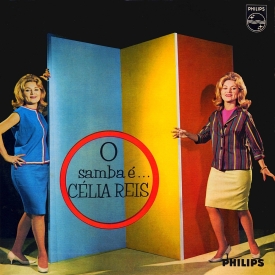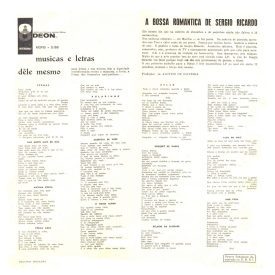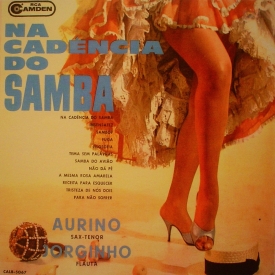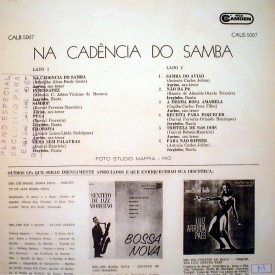Rio was introduced by Os Cariocas in June 1963. Although actually only the B-side of Pra Que Chorar, released in advance of the album As Bossas dos Cariocas, the catchy Rio became a hit with radio stations and the public, reaching number 31 in the year-end charts and becoming Os Cariocas’s most successful single release.
Even though the number of recordings declined noticeably at the end of the 1960s, the buoyant Rio became an instant bossa nova classic, with around 100 recordings to date. Roberto Menescal himself recorded the song in 1963 and 1964, and then a few more times from 1987 onwards.
Selected recordings of Rio:
1. Os Cariocas from the single Pra Que Chorar b/w Rio (1963, Philips P-61.207) and the album As Bossa dos Cariocas (1963, Philips P 632.152 L)


Artwork for As Bossa dos Cariocas by Paulo Brèves
2. Roberto Menescal from the album A Bossa Nova de Roberto Menescal e Seu Conjunto (1963, Elenco ME-3)


Artwork for A Bossa Nova de Roberto Menescal e Seu Conjunto by César G. Villela with photograph by Francisco Pereira
3. Lúcio Alves from the album Balançamba (1963, Elenco ME-2)


Artwork for Balançamba by César G. Villela with photographs by Francisco Perreira
4. Waltinho (Walter Gonçalves) from the album Magi Ritmo (1963, Magisom GMLP 1010)


5. Sylvia Telles from the album Bossa, Balanço, Balada (1963, Elenco ME-5)


Artwork for Bossa, Balanço, Balada by César G. Villela with photographs by Francisco Perreira
6. Hélio Mendes e Seu Trio Vagalume from the album Na Bossa (1963, Musiplay LPM 1110), also released as Bossa Castelinho credited to Quarteto Arpoador (1965, Esquema EDL-MU 5024 and 1965, Egal EDL-MU 5024)





Artwork for Bossa Castelinho by Joselito with photographs by Mafra
7. Pery Ribeiro from the album Pery é Todo Bossa (1963, Odeon MOFB 3314)


Artwork for Pery é Todo Bossa with photograph by Mafra
8. Lauro Paiva from the album Tim… Dom… Dom… – Lauro Paiva e Seu Conjunto e Coro do Clube do Guri (1963, Caravelle LP-CAR 33.003)


9. Marlene from the single Rio b/w Nosso Cantinho (1963, Continental 78-255)
10. Tamba Trio from the album Avanço (1963, Philips P 632.154 L)


Artwork for Avanço by Paulo Brèves with photograph by Francisco Perreira
11. Orquestra Brasil Moderno from the album A Revolução (1963, Odeon MOFB 3357)


12. Trio Samba from the album Samba! Samba! Samba! (1964, Philips P 632.198 L)


Artwork for Samba! Samba! Samba! by Paulo Brèves
13. Roberto Menescal from the album Bossa Nova (1964, Imperial/Odeon IMP 30.060)


14. Agostinho dos Santos from the album Vanguarda (1964, RGE XRLP 5231)


15. Os Intocáveis from the album Os Intocáveis (1964, Audio Fidelity AFLP 2004)


16. Ely Arcoverde from the album Balanço, Balanço, Balanço (1964, RGE XRLP 5235)


17. Os Copa Vips from the album Samba “Comme Il Faut” (1964, Copacabana CLP 11358)


18. Zézinho (José Batista da Silva Júnior) from the album Rio… Suave é a Noite (1964, Cartaz LPC-5001)


19. Paulinho Nogueira from the album A Nova Bossa é Violão (1964, RGE XRLP 5227)


Artwork for A Nova Bossa é Violão by Tide Hellmeister
20. Manfredo Fest from the album Evolução (1964, RGE XRLP 5236)


21. Edgar e Os Tais from the album O Assunto… é Edgard (1964, Farroupilha LPFA-404)


Artwork for O Assunto… é Edgard by Parlagreco
22. Mário Gennari Filho from the album Sucessos (1965, Odeon MOFB 3425)

23. João Donato from the album A Bossa Muito Moderna de João Donato e Seu Trio (1965, Polydor LPNG 4107)

Artwork for A Bossa Muito Moderna de João Donato e Seu Trio by Paulo Brèves
24. Edmundo Peruzzi from the album Rio-Show (1965, Independente STU-01)


25. The Ipanema Pop Orchestra from the album Bossa Nova for Swingin’s Lovers (1965, London/Odeon LLB 1001)

26. Lyrio Panicali from the album Lyrio Panicali Faz Samba em 2 Tempos (1967, Ritmos/Codil CDL 13007)


Selected recordings of Rio originally not issued in Brazil:
1. Paul Winter with Luiz Bonfa, Roberto Menescal and Luiz Eça from the album Rio (1965, Columbia [USA] CS 9115)


![]()
RIO
Rio que mora no mar • Sorrio pro meu Rio • Que tem no seu mar • Lindas flores que nascem morenas • Em jardins de sol
Rio, serras de veludo • Sorrio pro meu Rio • Que sorri de tudo • Que é dourado quase todo dia • E alegre como a luz
Rio é mar, eterno se fazer amar • O meu Rio é lua • Amiga branca e nua
É sol, é sal, é sul • São mãos se descobrindo em todo azul • Por isso é que meu Rio da mulher beleza • Acaba num instante com qualquer tristeza • Meu Rio que não dorme porque não se cansa • Meu Rio que balança
Sou Rio, sorrio • Sou Rio, sorrio • Sou Rio, sorrio • Sou Rio, sorrio • Sou Rio, sorrio



























































































































































































































































